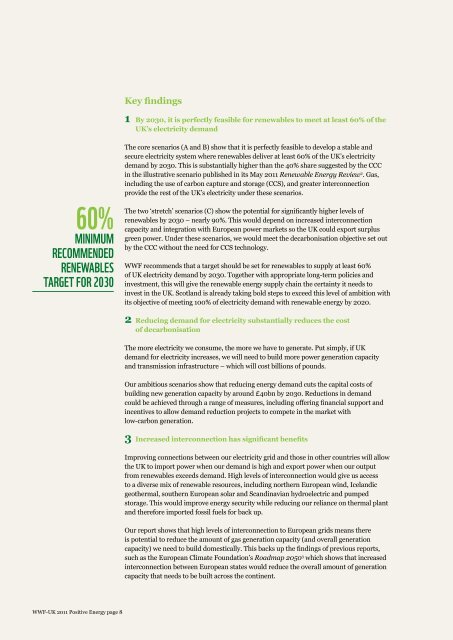Positive Energy: how renewable electricity can transform ... - WWF UK
Positive Energy: how renewable electricity can transform ... - WWF UK
Positive Energy: how renewable electricity can transform ... - WWF UK
You also want an ePaper? Increase the reach of your titles
YUMPU automatically turns print PDFs into web optimized ePapers that Google loves.
Key findings<br />
1 By 2030, it is perfectly feasible for <strong>renewable</strong>s to meet at least 60% of the<br />
<strong>UK</strong>’s <strong>electricity</strong> demand<br />
60%<br />
MINIMUM<br />
RECOMMENDED<br />
RENEWABLES<br />
TARGET FOR 2030<br />
The core scenarios (A and B) s<strong>how</strong> that it is perfectly feasible to develop a stable and<br />
secure <strong>electricity</strong> system where <strong>renewable</strong>s deliver at least 60% of the <strong>UK</strong>’s <strong>electricity</strong><br />
demand by 2030. This is substantially higher than the 40% share suggested by the CCC<br />
in the illustrative scenario published in its May 2011 Renewable <strong>Energy</strong> Review 2 . Gas,<br />
including the use of carbon capture and storage (CCS), and greater interconnection<br />
provide the rest of the <strong>UK</strong>’s <strong>electricity</strong> under these scenarios.<br />
The two ‘stretch’ scenarios (C) s<strong>how</strong> the potential for signifi<strong>can</strong>tly higher levels of<br />
<strong>renewable</strong>s by 2030 – nearly 90%. This would depend on increased interconnection<br />
capacity and integration with European power markets so the <strong>UK</strong> could export surplus<br />
green power. Under these scenarios, we would meet the decarbonisation objective set out<br />
by the CCC without the need for CCS technology.<br />
<strong>WWF</strong> recommends that a target should be set for <strong>renewable</strong>s to supply at least 60%<br />
of <strong>UK</strong> <strong>electricity</strong> demand by 2030. Together with appropriate long-term policies and<br />
investment, this will give the <strong>renewable</strong> energy supply chain the certainty it needs to<br />
invest in the <strong>UK</strong>. Scotland is already taking bold steps to exceed this level of ambition with<br />
its objective of meeting 100% of <strong>electricity</strong> demand with <strong>renewable</strong> energy by 2020.<br />
2 Reducing demand for <strong>electricity</strong> substantially reduces the cost<br />
of decarbonisation<br />
The more <strong>electricity</strong> we consume, the more we have to generate. Put simply, if <strong>UK</strong><br />
demand for <strong>electricity</strong> increases, we will need to build more power generation capacity<br />
and transmission infrastructure – which will cost billions of pounds.<br />
Our ambitious scenarios s<strong>how</strong> that reducing energy demand cuts the capital costs of<br />
building new generation capacity by around £40bn by 2030. Reductions in demand<br />
could be achieved through a range of measures, including offering financial support and<br />
incentives to allow demand reduction projects to compete in the market with<br />
low-carbon generation.<br />
3 Increased interconnection has signifi<strong>can</strong>t benefits<br />
Improving connections between our <strong>electricity</strong> grid and those in other countries will allow<br />
the <strong>UK</strong> to import power when our demand is high and export power when our output<br />
from <strong>renewable</strong>s exceeds demand. High levels of interconnection would give us access<br />
to a diverse mix of <strong>renewable</strong> resources, including northern European wind, Icelandic<br />
geothermal, southern European solar and S<strong>can</strong>dinavian hydroelectric and pumped<br />
storage. This would improve energy security while reducing our reliance on thermal plant<br />
and therefore imported fossil fuels for back up.<br />
Our report s<strong>how</strong>s that high levels of interconnection to European grids means there<br />
is potential to reduce the amount of gas generation capacity (and overall generation<br />
capacity) we need to build domestically. This backs up the findings of previous reports,<br />
such as the European Climate Foundation’s Roadmap 2050 3 which s<strong>how</strong>s that increased<br />
interconnection between European states would reduce the overall amount of generation<br />
capacity that needs to be built across the continent.<br />
<strong>WWF</strong>-<strong>UK</strong> 2011 <strong>Positive</strong> <strong>Energy</strong> page 8

















